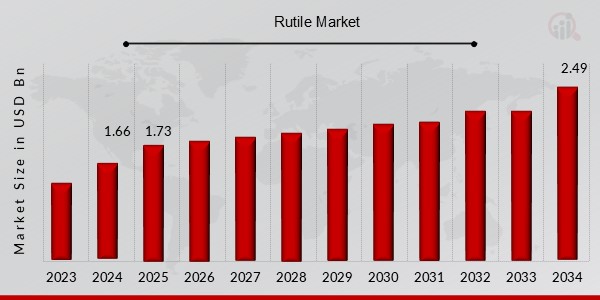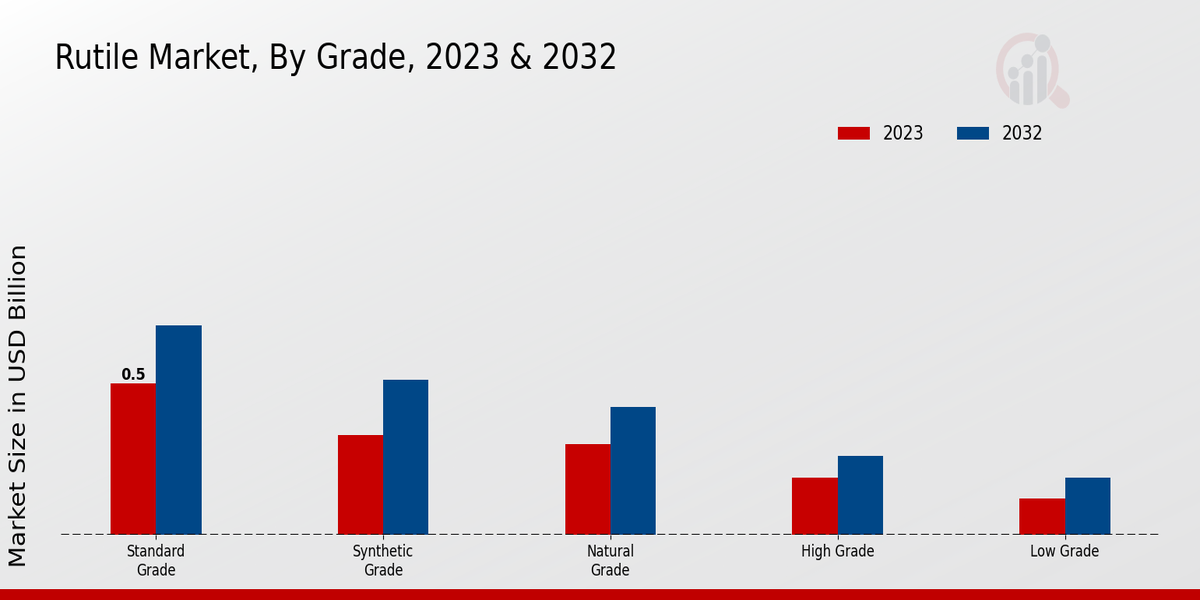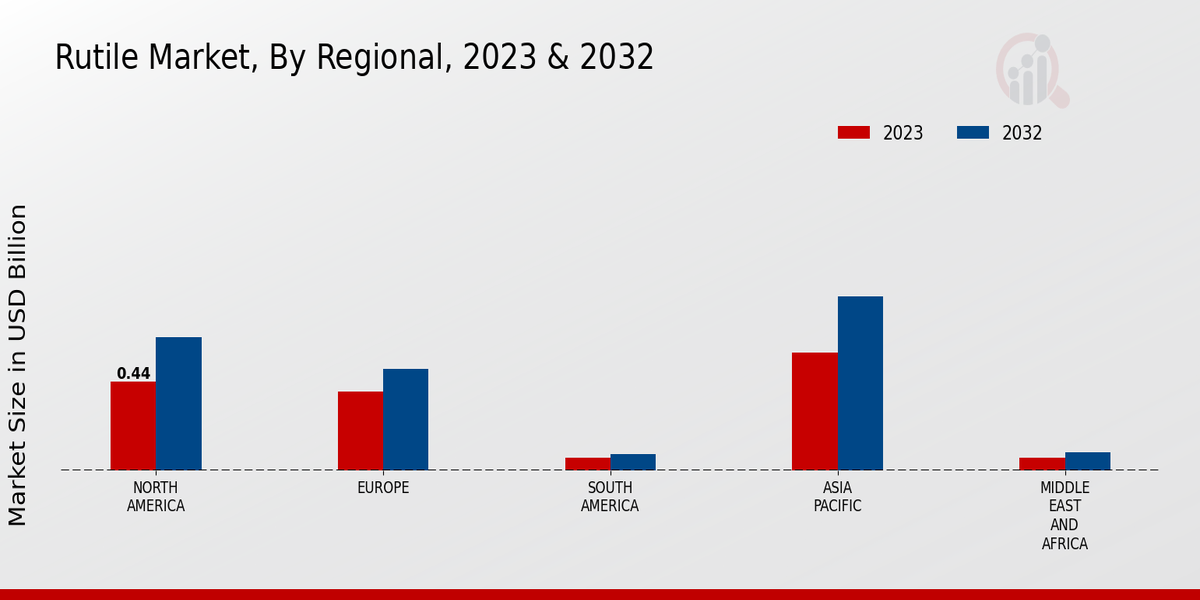Global Rutile Market Overview
The Rutile Market Size was estimated at 1.66 (USD Billion) in 2024. The Rutile Industry is expected to grow from 1.73 (USD Billion) in 2025 to 2.49 (USD Billion) by 2034. The Rutile Market CAGR (growth rate) is expected to be around 4.1% during the forecast period (2025 - 2034).
Key Rutile Market Trends Highlighted
Key Trends and Opportunities
Rutile market growth is likely to be fueled further by the increasing need for titanium dioxide, which is used extensively in the production of paints, coatings, plastics and ceramics. Rutile is also widely used as a flux in welding and a range of precast asphalt refractories, which promote growth lock-in.
Key market drivers include the expansion of the construction sector in developing countries, which in turn increases the demand for TiO2-based paint and paints. At last, such factors as the growing concern of customers about environmental regulations and the increase in the use of green technology are also boosting the market for non-poisonous and strong rutile.
New opportunities exist to find new products, such as utilizing rutile in photovoltaic cells, more efficient filtration systems, and catalysis. Also, the search for other rutile sources, such as synthetic rutile, will provide avenues for sustainable growth in the market. There are also some tendencies in the rutile market that risk consolidation, as, one by one, all the bigger market players purchase smaller companies to increase their market size. Such evolution of techniques of extraction and processing is improving efficiency and cutting down costs, enabling different sectors to access rutile at competitive prices.

Source: Primary Research, Secondary Research, MRFR Database and Analyst Review
Rutile Market Drivers
Rising Demand for Titanium Dioxide Pigment
Titanium Dioxide Titanium dioxide’s most significant use at present is in the production of paints and coatings, and plastics, printing subsequently and writing inks, paper, and board, pharmaceuticals, and other chemicals and disinfectants. Titanium dioxide is a white pigment used in a vast range of products. Rutile is the most usual form of TiO2, and it is favored for its high refractive index and brightness. The rising demand for TiO2 pigment is anticipated to be the archetypical driver of growth for the worldwide rutile market.The construction business is one of the significant users of TiO2 pigment, and the requirement and the necessity for housing and infrastructure is booming in evolving countries. This is one of the reasons why the demand for rutile is increasing. Additionally, the demand for TiO2 pigment in the automotive and aerospace industries is assumed to encourage the market further. Titanium Dioxide Market The global titanium dioxide market is poised to grow at a CAGR of around 4.5% from 2024 to 2032.It is estimated to achieve a value of USD 29.5 billion by 2032. The growth of titanium dioxide is forecasted to be propelled by the increasing demand in general industries, namely, paints and coatings, plastics, paper and ceramics. Expanding demand in developing nations is also expected to boost market growth. The region that is expected to have most of the market share is Asia Pacific, and it is estimated to account for more than 50% of the global market share.
Increasing Use in Welding and Metal Fabrication
Rutile is also used as a flux in welding and metal fabrication. Rutile fluxes use the impurities removal from the weld pool and prevent the weld metal from oxidation. The rise in the welding and metal fabricating activities in the automotive, construction, and shipbuilding regions of the world is thereby expected to augment the demand for rutile. The world welding and metal fabrication market is expected to grow at a CAGR of around 4.0% from 2024 to 2032, and it is anticipated to reach a market size of about USD 450 billion by 2032.The rise in the welding demands of the automotive, construction, and shipbuilding industries is likely to be the key factor driving welding and metal fabrication markets within the next decade. The emergence of welding and metalworking activities in the developing regions is also expected to add to the growth of the market during the forecast period. In terms of world regions, the A-Pac region is anticipated to be the leading market for welding and metal fabrication, which is expected to account for more than 50% of the total global market share.
Growing Demand for Refractories
Rutile is also used in the production of refractories, which are materials that can withstand high temperatures. Refractories are used in a variety of applications, including furnaces, kilns, and incinerators. The growing demand for refractories in the steel, cement, and glass industries is expected to drive up demand for rutile. The global refractories market is expected to grow at a CAGR of 4.8% from 2024 to 2032, reaching a value of USD 40 billion by 2032.This growth is expected to be driven by the increasing demand for refractories in various industries, such as steel, cement, and glass. The rising demand for refractories in emerging economies is also expected to contribute to the growth of the market. The Asia-Pacific region is expected to be the largest market for refractories, accounting for over 50% of the global market share.
Rutile Market Segment Insights:
Rutile Market Grade Insights
Rutile Market grade segment is categorized into standard grade, synthetic grade, natural grade, high grade, low grade, and AR grade. It includes various different properties and applications used in different industries, catering to various sectors. The standard grade is used majorly in the production of refractories and pigments and welding fluxes, with an estimated market of around USD 650 million in 2023. Synthetic grade with market value of USD 420 million in 2023, produced using chemicals; it offers high purity. The main end-selling industry for the synthetic grade is the electronics industry and is used majorly in the manufacturing of capacitors and semiconductors.On the other hand, Natural Grade accounted for an estimated of USD 380 million in 2023, it is directly sourced from nature, resulting in impurities. Thus, purity levels are not high; hence, they are used in applications where purity is not of major concern, including the manufacture of welding electrodes and abrasives. High grade is estimated in terms of value at USD 240 million in 2023. The grade is highly pure and low on impurity levels, which makes it way beyond the other grades. High grade is basically used in industries such as the making of aerospace, medical devices and precision optics, which requires high-quality grade parameters.Low grade, with a value of around USD 160 million in 2023, includes higher levels of impurities, as it is used in applications where pricing is a major concern. AR grade, worth around USD 120 million in 2023, contains the least impurities and is mainly meant for application usage in analysis and research purposes. For each grade, the global market is expected to grow during the forecast period, driven by the growing demand from industries, technological enhancement, and product expansion.

Source: Primary Research, Secondary Research, MRFR Database and Analyst Review
Rutile Market Application Insights
The Rutile Market segmentation by Application includes Welding and Cutting, Glass and Ceramics, Paints and Coatings, Electronics, Personal Care, Foundry Industry, and Refractories. At 40% and growing, welding and cutting enjoy the largest market share. This segment is expected to remain dominant throughout the forecast period. The Glass and Ceramics segment is expected to grow the most over the next several years. Paints and Coatings will also grow, albeit at a slower rate, given growing use of rutile as pigment and filler in paints and coatings.The Electronics segment is expected to grow, albeit at a slower pace, given interest in electronics, which use rutile to produce components. The Personal Care segment is projected to grow, also at a relatively slow rate, because of growing interest in the production of cosmetics and personal care products. Growth in the Foundry Industry segment is also expected to be moderate, giving rising demand for rutile to produce foundry products. It is also expected that the Refractories segment will grow, also at a relatively slow pace, because of increasing demand for rutile to the production of refractories.
Rutile Market Particle Size Insights
The Rutile Market is segmented by particle size into fine, medium, coarse, and ultrafine. Among these, the fine particle size segment is expected to hold the largest market share in 2023, and it is projected to continue its dominance throughout the forecast period. This is primarily attributed to the increasing demand for fine particle size rutile in various applications such as paints, coatings, plastics, and ceramics. The medium particle size segment is expected to witness significant growth over the forecast period due to its increasing use in refractory applications.The coarse particle size segment is expected to hold a steady market share during the forecast period. The ultrafine particle size segment is expected to witness moderate growth over the forecast period due to its increasing use in high-performance applications such as electronics and aerospace.
Rutile Market Purity Level Insights
Purity Level segment plays a vital role in determining the Rutile Market revenue, with different purity levels catering to specific end-use industries. In 2023, the 'High Purity' segment held the largest market share due to the increasing demand for high-purity rutile in the production of optical fibers and advanced ceramics. 'Ultra High Purity' rutile is gaining traction in the electronics industry, driven by the rising demand for semiconductors and printed circuit boards. The 'Medium Purity' and 'Low Purity' segments are expected to witness steady growth, driven by their wide usage in paints coatings, plastics, and glass industries.Overall, the purity level segment will continue to shape the global volatile market segmentation, with each purity level offering unique properties and applications that will contribute to market growth in the coming years.
Rutile Market Source Insights
The Rutile Market is segmented by source into Titanium Ore, Ilmenite Ore, and Rutile Sand. Titanium Ore: Titanium ore is the most common source of rutile, accounting for around 90% of global production. It is a black or brown mineral that is found in igneous and metamorphic rocks. The major titanium ore producing countries are China, Australia, South Africa, and Russia. Ilmenite Ore: Ilmenite ore is another important source of rutile. It is a black or gray mineral that is found in igneous and metamorphic rocks. The major ilmenite ore producing countries are China, Australia, India, and Norway.Rutile Sand: Rutile sand is a naturally occurring sand that is rich in rutile. It is found in alluvial deposits and beach sands. The major rutile sand producing countries are Australia, South Africa, and Sri Lanka. The Rutile Market segmentation data provides valuable insights into the industry dynamics and helps identify key trends and opportunities. The increasing demand for rutile in the production of titanium dioxide, which is used in a wide range of applications such as paints, plastics, and ceramics, is driving the growth of the market.
Rutile Market Regional Insights
The regional segmentation of the Rutile Market offers insights into the market's geographical distribution and performance. North America is expected to dominate the market, with a significant share due to the presence of established industries and growing demand from sectors such as aerospace, automotive, and construction. Europe is another key region, driven by strict environmental regulations and the increasing adoption of rutile in various applications. APAC is projected to witness substantial growth, fueled by the expanding manufacturing sector and urbanization in countries like China and India.South America and MEA are emerging markets with untapped potential, offering opportunities for market expansion. Overall, the Rutile Market is expected to grow steadily in the coming years, driven by increasing demand from diverse industries and the growing awareness of rutile's unique properties.

Source: Primary Research, Secondary Research, MRFR Database and Analyst Review
Rutile Market Key Players And Competitive Insights:
Outlook of Rutile Market sector players are focusing on ways to gain a competitive edge in the industry. Some of the leading Rutile Market players are focusing on expanding their global presence by introducing innovative solutions and adopting a strategy of acquisitions and partnerships. Moreover, the players are investing extensively in research and development to deliver high-quality products. The Rutile Market industry is characterized by a significant degree of competition among established players as well as between existing and emerging players. The major players in the market are employing innovative technologies and forming strategic alliances to gain a competitive edge in the target market. Moreover, the players are also aggressively engaging in mergers and acquisitions to consolidate their market presence and expand their geographical reach.
Iluka Resources Limited is a prominent global producer of mineral sands, including rutile, and it is headquartered in Australia. The company is the leading producer of rutile and has a strong focus on sustainability and innovation. The company operates multiple mines and processing facilities in Australia and has operations in Sierra Leone and the United States as well. Iluka Resources delivers rutile to a range of industries, including major manufacturers of paints, plastics and ceramics. The company operates in the Rutile Market industry with a diversified product offering. The company's major products include rutile, zircon, and titanium dioxide slag. Iluka Resources is heavily focused on its sustainability and innovation and delivering solutions that enable responsible mining.Kenmare Resources plc also operates as a key player in the Rutile Market industry. Kenmare Resources operates the Moma Titanium Minerals Mine, based in Mozambique. The Moma Titanium Minerals Mine is one of the world’s largest titanium mineral deposits. The company has a long-term supply agreement with Iluka Resources to supply stable rutile production. The company is focused on operational efficiency and implementing measures for cost-saving opportunities to deliver higher profitability. The company has implemented initiatives to reduce its environmental impact and has a strong history of operational excellence. Kenmare Resources won the ILO Medal for Mineral Sector Companies in 2019 for outstanding efforts to prevent industrial accidents.
Key Companies in the Rutile Market Include:
- Bushveld Minerals
- Base Resources
- Iluka Resources
- Albemarle
- Lucapa Diamond Company
- Huntsman
- Sierra Rutile
- Tronox
- Evonik
- Titan Mineral
- Kronos Worldwide
- Maximus Resources
- Cristal
- Rio Tin
- Kenmare Resources
Rutile Market Industry Developments
Increasing demand from the aerospace industry, particularly for manufacturing jet engine components, is a key factor driving market growth. Additionally, rising consumption in the ceramics and glass industries, owing to Rutile's high refractive index and opacity, is fueling market expansion. Geographically, the Asia-Pacific region is anticipated to dominate the market throughout the forecast period, with major contributions from China, India, and Japan. Strategic partnerships and collaborations among market players are expected to shape the competitive landscape in the coming years.
Rutile Market Segmentation Insights
- Rutile Market Grade Outlook
- Standard Grade
- Synthetic Grade
- Natural Grade
- High Grade
- Low Grade
- AR Grade
- Rutile Market Application Outlook
- Welding and Cutting
- Glass and Ceramics
- Paints and Coatings
- Electronics
- Personal Care
- Foundry Industry
- Refractories
- Rutile Market Particle Size Outlook
- Fine Particle Size
- Medium Particle Size
- Coarse Particle Size
- Ultrafine Particle Size
- Rutile Market Purity Level Outlook
- High Purity
- Medium Purity
- Low Purity
- Ultra High Purity
- Rutile Market Source Outlook
- Titanium Ore
- Ilmenite Ore
- Rutile Sand
- Rutile Market Regional Outlook
- North America
- Europe
- South America
- Asia Pacific
- Middle East and Africa
| Report Attribute/Metric |
Details |
| Market Size 2024 |
1.66 (USD Billion) |
| Market Size 2025 |
1.73 (USD Billion) |
| Market Size 2034 |
2.49 (USD Billion) |
| Compound Annual Growth Rate (CAGR) |
4.1% (2025 - 2034) |
| Report Coverage |
Revenue Forecast, Competitive Landscape, Growth Factors, and Trends |
| Base Year |
2024 |
| Market Forecast Period |
2025 - 2034 |
| Historical Data |
2020 - 2024 |
| Market Forecast Units |
USD Billion |
| Key Companies Profiled |
Bushveld Minerals, Base Resources, Iluka Resources, Albemarle, Lucapa Diamond Company, Huntsman, Sierra Rutile, Tronox, Evonik, Titan Mineral, Kronos Worldwide, Maximus Resources, Cristal, Rio Tin, Kenmare Resources |
| Segments Covered |
Grade, Application, Particle Size, Purity Level, Source, Regional |
| Key Market Opportunities |
Growing demand for white pigments Increasing use in electronics Expanding aerospace industry Rising consumption in emerging markets Technological advancements in extraction techniques |
| Key Market Dynamics |
Rising demand from aerospace increasing consumption in paints and coatings growing automotive industry expanding construction sector technological advancements |
| Countries Covered |
North America, Europe, APAC, South America, MEA |
Frequently Asked Questions (FAQ) :
The Rutile market is projected to be valued at approximately USD 1.66 billion in 2024.
The Rutile market is expected to exhibit a CAGR of 4.1% between 2025 and 2034.
The Asia-Pacific region is expected to dominate the Rutile market, owing to the increasing demand from emerging economies such as China and India.
Rutile is primarily used in the production of titanium dioxide, which is utilized in various industries such as paints, plastics, and ceramics.
Key competitors in the Rutile market include Iluka Resources, Rio Tinto, Tronox, Kenmare Resources, and Cristal.
The growth of the Rutile market is primarily driven by the increasing demand for titanium dioxide in various industries, particularly in the construction and automotive sectors.
Challenges faced by the Rutile market include environmental regulations, fluctuations in raw material prices, and competition from alternative materials.
The Rutile market is expected to witness steady growth in the coming years, driven by increasing demand from emerging economies and technological advancements.
Key trends shaping the Rutile market include the growing adoption of sustainable mining practices, the development of new applications for titanium dioxide, and the increasing use of Rutile in advanced materials.
The outlook for the Rutile market over the next five years is positive, with a projected CAGR of 4.1%. The growth is expected to be driven by increasing demand from various industries, particularly in the Asia-Pacific region.
















